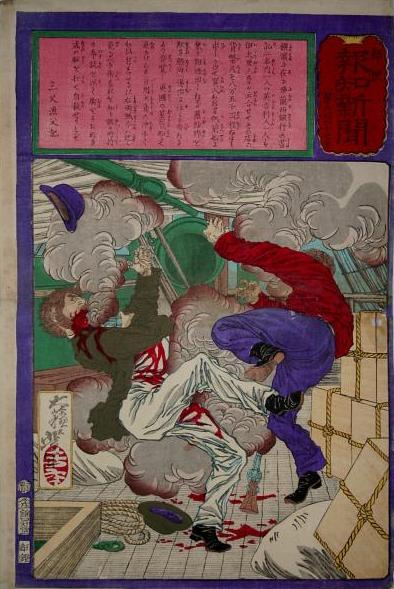|
Yubin hochi shinbun
No. 647 -- 1875-4-11
Foreign clerks shoot selves
Story translation
Two clerks of a French bank in Yokohama, one an Englishman, one an Italian, contrived to steal about 85,000 of the place's money. The boarded a sailing boat they had previously bought and began to flee, but they were exposed because they had deceived some sheep and told they were going to Atami for a hotspring cure. They were chased by steamship of England and were overtaken at an offing of Zushū Ōshima. And the right [above] two thieves, knowing they now had utterly no means of escape, each with a pistol in possession killed himself shooting through [his] chest or shooting [his] head.
Written by Mitsumata Gyofu
[Translated by William Wetherall]
Commentary
Suicide by firearms -- the method of choice for those who have access to them.
Suicide together -- a matter of shared circumstances and sense of fate.
Suicide on the verge of capture -- an impulse common to culprits and warriors alike.
This story reads like an ethnic joke. "An Englishman and an Italian are clerking at a French bank in Japan. One day, in the company of some Japanese sheep they are keeping for pleasure, they decide to embezzle some money. . . ."
The men flee, perhaps without paying the their sheep their shed and feed feeds. And the sheep, not about to let their hairy herders pull the wool over their eyes, bleated their pillow talk to the authorities.
sheep
"Sheep" was contemporary slang for a female Homo japanicus who shared a lair with a male Homo westernus who wandered to Japan. It reflects the expression 羅紗綿 (rashamen), which consists of a character transliteration of Portuguese "raxa" (ラシャ 羅紗) and Sino-Japanese "men" (綿) meaning "cotton".
Raxa refers to a thick, closely woven woolen fabric brought to Japan by Portuguese during the late 16th century, and later by Dutch and Chinese traders. It was used in Chinese-style sleeveless short coats worn as armor by warriors, and the sleeveless shortcoats worn by fire fighters, among other products.
Kōjien, the dictionary, states that "rashamen", meaning sheep, was used to disparage Japanese woman who became the mistress of a western oceaner (西洋人 seiyōjin) who had come to Japan -- based on the popular story that western ocean (西洋 seiyō) sailors raised sheep on their ships and violated them.
Kōjien gives both 外妾 (gaishō) meaning "out[lander] mistress", and 洋妾 (yōshō) meaning "[western] ocean[er] mistress", as synonyms. And, in fact, these terms are sometimes found with furigana reading らしゃめん (rashamen).
In time, rashamen referred not only to a "pleasure woman" (遊女 yūjo) who entertained a "westerner" but also to an ordinary women who became the lover, mistress, or wife of such an alien.
Zushu
Zushū (豆州) -- then written づしう (dzushiu) but now written ずしゅう (zushuu) -- was another name for the province of Izu (伊豆). Izu Ōshima would be straight ahead of a ship as it passed through the Uraga Channel from Tokyo Bay, and would be to the port as the ship rounded Miura peninsula and crossed Sugami Bay for the hotspring resort of Atami on the coast of Izu Peninsula of what is now Shizuoka prefecture.
pistol
The term 拳銃 is read "kenjū" in Sino-Japanese and means "hand gun". In this story, however, it was marked with furigana reading ぴすとる (pisutoru).
Print variations
There are at least two variations of this print. The earlier edition has more colors, the color scheme is more complicated, and the details are sharper.
A very ratty copy of the earlier edition was shown at the Shibun nishikie ten exhibition which travelled to four museums in Japan from 1988 to 1989. A black-and-white image is shown in the exhibiton catalogs (Itabashi-ku 1989, page 49).
An image of a copy of the later edition in Meiji Bunko is shown on Bunsei Shoin's CD-ROM (Tsuchiya 2000). A copy of the later edition in the Rikken Collection was shown at CCMA's 2008 exhibition and the related book (CCMA 2008, page 178).
Serendipity
I had seen a couple of black-and-white images of this print, one very ratty, and a color image on Tsuchiya 2000. I saw a copy of the actual print for the first time, in mid January 2008, at the TNS / YHS exhibition at CCMA. I never thought I'd find a copy of my own.
The very next week I picked up a reasonably good copy on action from a seller in Omotesando. After it came, while searching for information about the writer of the story, I found another copy at a shop in Fukuoka. When it came, I immediately saw that the impressions were somewhat different.
So within two weeks, I had found different versions of a print I thought I might never own. The earlier edition has more colors, the color scheme is more complicated, and the details are sharper.
The black-and-white copies in Keyes 2000 (page 38, Herbert R. Cole Collection) and Itabashi-ku 1989 (page 49, ratty, unattributed) are of the earlier edition. The copies in Segi (1982:XYZ, color, 1985:49, monochrome, of the same print, unattributed), and the color copies on Tsuchiya 2000 (YHC0647, Meiji Bunko) and in CCMA 2008 (page 178, Rikken Collection) are of later editions.
| 